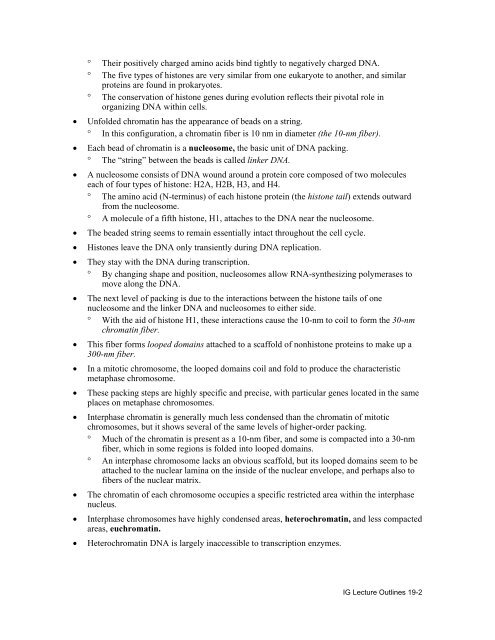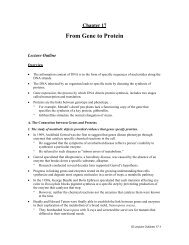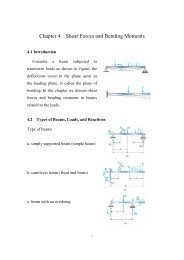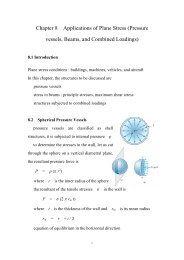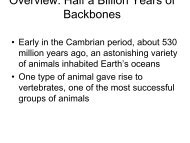chapter 19 the organization and control of eukaryotic genomes
chapter 19 the organization and control of eukaryotic genomes
chapter 19 the organization and control of eukaryotic genomes
You also want an ePaper? Increase the reach of your titles
YUMPU automatically turns print PDFs into web optimized ePapers that Google loves.
° Their positively charged amino acids bind tightly to negatively charged DNA.° The five types <strong>of</strong> histones are very similar from one eukaryote to ano<strong>the</strong>r, <strong>and</strong> similarproteins are found in prokaryotes.° The conservation <strong>of</strong> histone genes during evolution reflects <strong>the</strong>ir pivotal role inorganizing DNA within cells.• Unfolded chromatin has <strong>the</strong> appearance <strong>of</strong> beads on a string.° In this configuration, a chromatin fiber is 10 nm in diameter (<strong>the</strong> 10-nm fiber).• Each bead <strong>of</strong> chromatin is a nucleosome, <strong>the</strong> basic unit <strong>of</strong> DNA packing.° The “string” between <strong>the</strong> beads is called linker DNA.• A nucleosome consists <strong>of</strong> DNA wound around a protein core composed <strong>of</strong> two moleculeseach <strong>of</strong> four types <strong>of</strong> histone: H2A, H2B, H3, <strong>and</strong> H4.° The amino acid (N-terminus) <strong>of</strong> each histone protein (<strong>the</strong> histone tail) extends outwardfrom <strong>the</strong> nucleosome.° A molecule <strong>of</strong> a fifth histone, H1, attaches to <strong>the</strong> DNA near <strong>the</strong> nucleosome.• The beaded string seems to remain essentially intact throughout <strong>the</strong> cell cycle.• Histones leave <strong>the</strong> DNA only transiently during DNA replication.• They stay with <strong>the</strong> DNA during transcription.° By changing shape <strong>and</strong> position, nucleosomes allow RNA-syn<strong>the</strong>sizing polymerases tomove along <strong>the</strong> DNA.• The next level <strong>of</strong> packing is due to <strong>the</strong> interactions between <strong>the</strong> histone tails <strong>of</strong> onenucleosome <strong>and</strong> <strong>the</strong> linker DNA <strong>and</strong> nucleosomes to ei<strong>the</strong>r side.° With <strong>the</strong> aid <strong>of</strong> histone H1, <strong>the</strong>se interactions cause <strong>the</strong> 10-nm to coil to form <strong>the</strong> 30-nmchromatin fiber.• This fiber forms looped domains attached to a scaffold <strong>of</strong> nonhistone proteins to make up a300-nm fiber.• In a mitotic chromosome, <strong>the</strong> looped domains coil <strong>and</strong> fold to produce <strong>the</strong> characteristicmetaphase chromosome.• These packing steps are highly specific <strong>and</strong> precise, with particular genes located in <strong>the</strong> sameplaces on metaphase chromosomes.• Interphase chromatin is generally much less condensed than <strong>the</strong> chromatin <strong>of</strong> mitoticchromosomes, but it shows several <strong>of</strong> <strong>the</strong> same levels <strong>of</strong> higher-order packing.° Much <strong>of</strong> <strong>the</strong> chromatin is present as a 10-nm fiber, <strong>and</strong> some is compacted into a 30-nmfiber, which in some regions is folded into looped domains.° An interphase chromosome lacks an obvious scaffold, but its looped domains seem to beattached to <strong>the</strong> nuclear lamina on <strong>the</strong> inside <strong>of</strong> <strong>the</strong> nuclear envelope, <strong>and</strong> perhaps also t<strong>of</strong>ibers <strong>of</strong> <strong>the</strong> nuclear matrix.• The chromatin <strong>of</strong> each chromosome occupies a specific restricted area within <strong>the</strong> interphasenucleus.• Interphase chromosomes have highly condensed areas, heterochromatin, <strong>and</strong> less compactedareas, euchromatin.• Heterochromatin DNA is largely inaccessible to transcription enzymes.IG Lecture Outlines <strong>19</strong>-2


